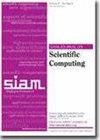计算多边形障碍物诱导的远场模式的高效频率无关数值方法
IF 2.6
2区 数学
Q1 MATHEMATICS, APPLIED
引用次数: 0
摘要
SIAM 科学计算期刊》,第 46 卷第 4 期,第 A2324-A2350 页,2024 年 8 月。 摘要。对于有理多边形障碍物的时谐散射问题,嵌入公式用一组相对较小(与频率无关)的典型入射角的远场模式来表达任何入射平面波引起的远场模式。虽然这些非凡的公式在理论上是精确的,但我们在此证明:(i) 它们在实践中对数值误差非常敏感;(ii) 对于特定的典型入射角集,即使是精确运算,也不可能直接计算出这些公式中的系数。只有克服这些实际问题,嵌入公式才能为计算大量入射角引起的远场模式提供高效方法。在此,我们将解决挑战 (i) 和 (ii),并通过数值实验来支持我们的理论。难题 (i) 利用计算复数分析技术得到了解决:我们将嵌入公式重新表述为复数等值线积分,并证明它对数值误差的敏感度要低得多。在实践中,这种等值线积分可以通过残差微积分进行有效评估。我们利用数值线性代数的技术解决了挑战 (ii):我们进行了超采样,考虑了比必要更多的典型入射角,从而扩大了有效系数向量集。然后可以使用最小二乘法或列子集选择法来选择系数向量。本文章由计算机程序翻译,如有差异,请以英文原文为准。
An Efficient Frequency-Independent Numerical Method for Computing the Far-Field Pattern Induced by Polygonal Obstacles
SIAM Journal on Scientific Computing, Volume 46, Issue 4, Page A2324-A2350, August 2024.
Abstract. For problems of time-harmonic scattering by rational polygonal obstacles, embedding formulae express the far-field pattern induced by any incident plane wave in terms of the far-field patterns for a relatively small (frequency-independent) set of canonical incident angles. Although these remarkable formulae are exact in theory, here we demonstrate that (i) they are highly sensitive to numerical errors in practice, and (ii) direct calculation of the coefficients in these formulae may be impossible for particular sets of canonical incident angles, even in exact arithmetic. Only by overcoming these practical issues can embedding formulae provide a highly efficient approach to computing the far-field pattern induced by a large number of incident angles. Here we address challenges (i) and (ii), supporting our theory with numerical experiments. Challenge (i) is solved using techniques from computational complex analysis: we reformulate the embedding formula as a complex contour integral and prove that this is much less sensitive to numerical errors. In practice, this contour integral can be efficiently evaluated by residue calculus. Challenge (ii) is addressed using techniques from numerical linear algebra: we oversample, considering more canonical incident angles than are necessary, thus expanding the set of valid coefficient vectors. The coefficient vector can then be selected using either a least squares approach or column subset selection.
Abstract. For problems of time-harmonic scattering by rational polygonal obstacles, embedding formulae express the far-field pattern induced by any incident plane wave in terms of the far-field patterns for a relatively small (frequency-independent) set of canonical incident angles. Although these remarkable formulae are exact in theory, here we demonstrate that (i) they are highly sensitive to numerical errors in practice, and (ii) direct calculation of the coefficients in these formulae may be impossible for particular sets of canonical incident angles, even in exact arithmetic. Only by overcoming these practical issues can embedding formulae provide a highly efficient approach to computing the far-field pattern induced by a large number of incident angles. Here we address challenges (i) and (ii), supporting our theory with numerical experiments. Challenge (i) is solved using techniques from computational complex analysis: we reformulate the embedding formula as a complex contour integral and prove that this is much less sensitive to numerical errors. In practice, this contour integral can be efficiently evaluated by residue calculus. Challenge (ii) is addressed using techniques from numerical linear algebra: we oversample, considering more canonical incident angles than are necessary, thus expanding the set of valid coefficient vectors. The coefficient vector can then be selected using either a least squares approach or column subset selection.
求助全文
通过发布文献求助,成功后即可免费获取论文全文。
去求助
来源期刊
CiteScore
5.50
自引率
3.20%
发文量
209
审稿时长
1 months
期刊介绍:
The purpose of SIAM Journal on Scientific Computing (SISC) is to advance computational methods for solving scientific and engineering problems.
SISC papers are classified into three categories:
1. Methods and Algorithms for Scientific Computing: Papers in this category may include theoretical analysis, provided that the relevance to applications in science and engineering is demonstrated. They should contain meaningful computational results and theoretical results or strong heuristics supporting the performance of new algorithms.
2. Computational Methods in Science and Engineering: Papers in this section will typically describe novel methodologies for solving a specific problem in computational science or engineering. They should contain enough information about the application to orient other computational scientists but should omit details of interest mainly to the applications specialist.
3. Software and High-Performance Computing: Papers in this category should concern the novel design and development of computational methods and high-quality software, parallel algorithms, high-performance computing issues, new architectures, data analysis, or visualization. The primary focus should be on computational methods that have potentially large impact for an important class of scientific or engineering problems.

 求助内容:
求助内容: 应助结果提醒方式:
应助结果提醒方式:


